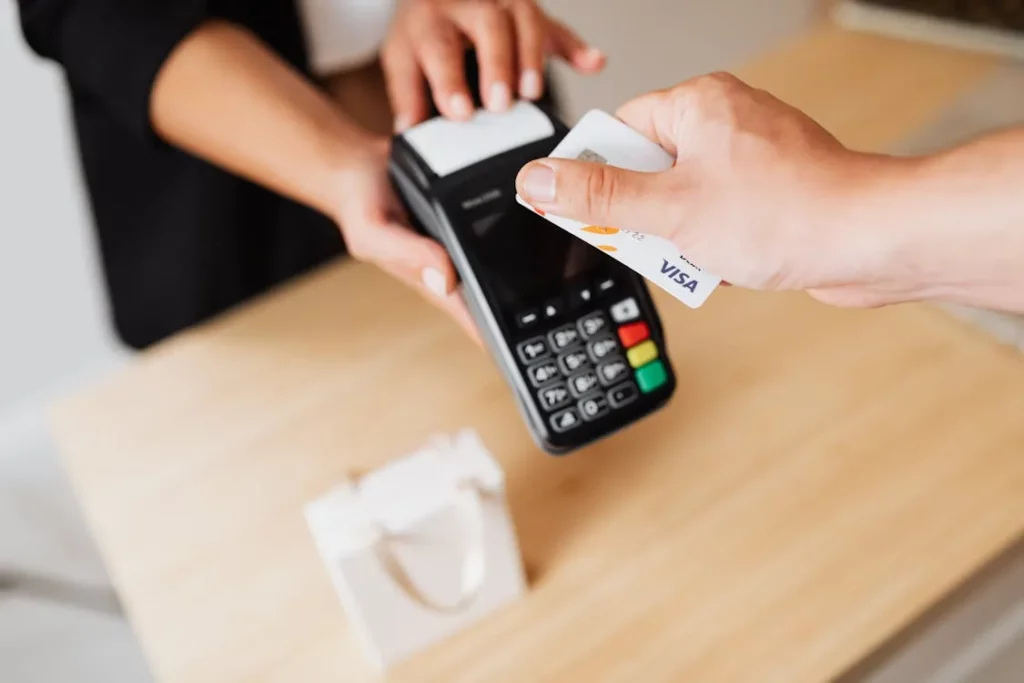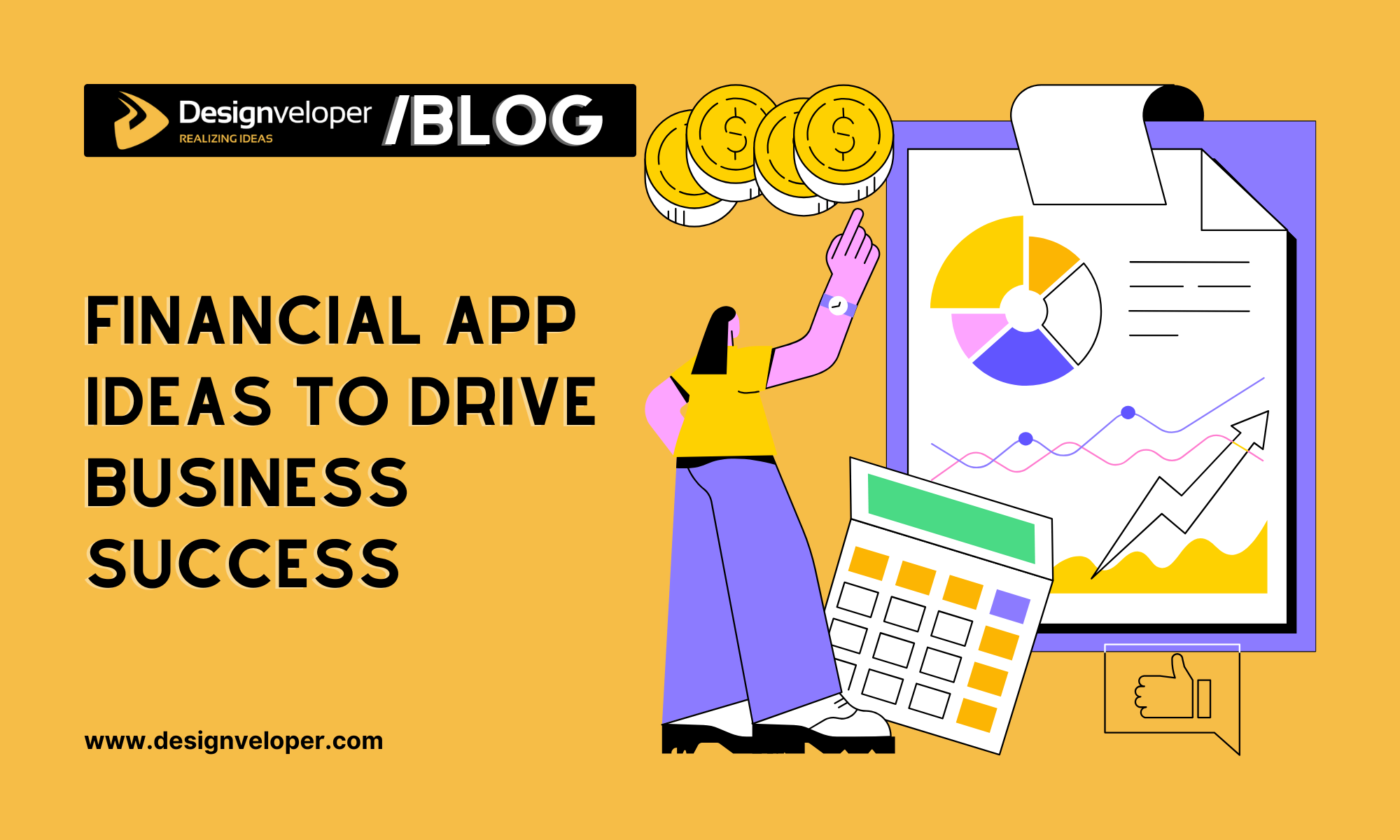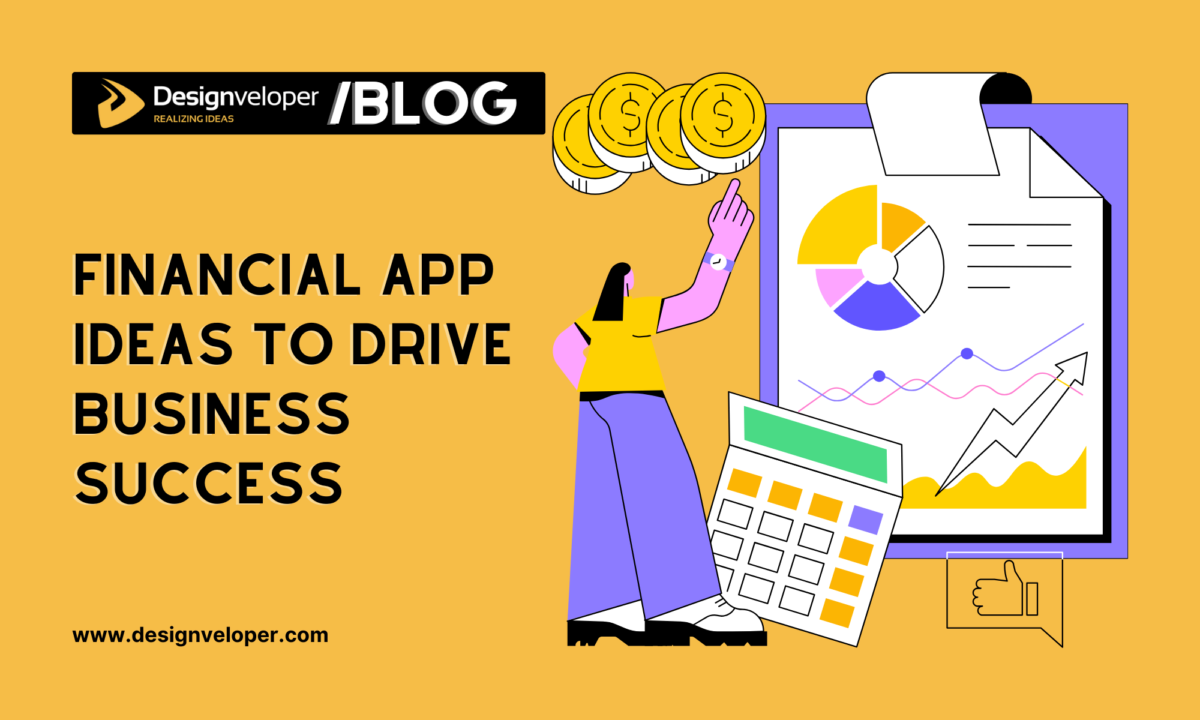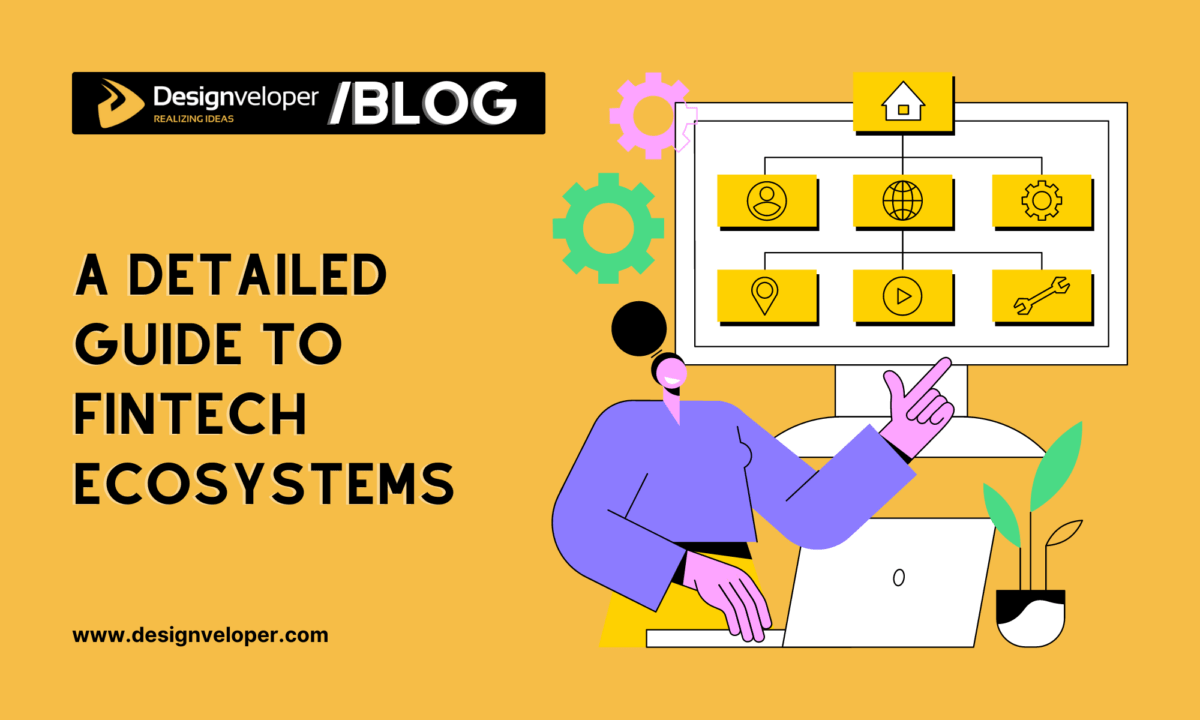
In the segment of the financial technologies (fintech), tremendous development is taking place, as the global financial app market may raise from USD 3.40 billion in 2025 to even USD 10.63 billion in 2033, growing at a pace of 15.3% CAGR. The role of this surge, however, lies in the necessity of digital solutions to help manage finances, the responsibility that has become a growing trend. But it all starts as ideas at first, and in this case, financial app ideas.
Using smartphone apps to manage finances is now a common practice, as it is shown by recent studies that 73% of smartphone users have used an app to manage their finances during the past month. Another third of Americans use three or more financial apps which corroborate the fact that this ‘tool’ is becoming an integral part of daily life for many Americans.
Innovative financial app ideas are pivotal in driving business success. Take personal finance management apps such as YNAB (You Need A Budget) as an example, which help users to budget and record expenses in order to improve users’ financial habits. Additionally, crowdfunding websites like Kickstarter allow entrepreneurs to raise funding and prove their business concepts.
In this article, we will explore ten financial app ideas that can propel business success, providing insights into their functionalities and the value they offer to both businesses and consumers.
Why You Need Financial App Ideas
The fintech industry is growing in a spectacular way, with the global market projected to amount to $492 billion by 2028, growing by a compound annual growth rate of 16.8%. This expansion underscores the increasing demand for innovative financial app ideas that can streamline operations, enhance customer engagement, and drive business success.

Personal finance management apps like YNAB (You Need A Budget) exemplify how effective financial app ideas can empower users to take control of their finances through zero-based budgeting. Also, bill reminder apps like TimelyBills, aiding users to keep account of their expenses and setting reminders scheduling time of payments along with timely notifications, is pushing forward towards less and missed payments and better financial responsibility.
Investing in well-conceived financial app ideas not only meets the growing consumer demand for digital financial solutions but also positions businesses at the forefront of the fintech revolution, fostering growth and long-term success.
How to Turn Financial App Ideas into Reality
Transforming financial app ideas into reality requires a strategic and systematic approach. As Designveloper, along with considerable experience and technical assets, we will take your business through the whole process.
1. Define Clear Objectives
Start by detailing the goals and features of your app for finance, taking into account what your dreamed up users are looking for. Taking this foundational step ensures that the app tackles real world financial problems in the proper way.
2. Conduct Thorough Market Research
You have to analyze the current market landscape to see trends, opportunities and competition. According to recent reports, it is estimated that the global fintech market will grow to $305 billion by 2025 offering incredible opportunities in the area of innovative financial solutions.
3. Collaborate with Experienced Developers

Team up with a seasoned app development team like Designveloper. Established in 2013, Designveloper has successfully delivered over 100 projects, and several of them are financial applications. With over 50 professionals we are web and mobile app development, UI/UX design and VOIP solutions specialists, we can turn your ideas into reality.
4. Focus on User-Centric Design
Aim to increase user satisfaction and retains users through an intuitive and user friendly user interface. In the end, our UI/UX designers will always strive to provide that seamless experience to users of financial apps.
5. Ensure Robust Security Measures
Security protocols are very critical in financial app development and may not be negotiated. Advanced encryption and compliance strategies are used to protect sensitive user data, and trust continues to be built.
6. Develop and Test Iteratively
Sprint and develop the app through agile methodologies in order to build it incrementally and test and receive feedback continuously. It is to work on the final product after refining then, and it meets the user expectations.
7. Plan for Deployment and Maintenance
A strategic launch plan is necessary after development. After launching the app, it is important that it remains updated since it would become irrelevant and stop working without updated content. Designveloper provides full support for your app so it can run longterm.
By following these steps and collaborating with Designveloper, businesses can effectively transform their financial app ideas into impactful, market-ready solutions.
Recommended reading: 80 Mobile App Ideas to Earn Big Money [Updated for 2023]
Top 10 Financial App Ideas for Businesses and Startups
With the financial technology (fintech) sector growing rapidly, businesses and startups are getting innovative financial management and operation tools to improve their operation. According to a new study, the market will be expected to reach USD 10.63 billion by 2033, growing at a CAGR of 15.3% during the forecast period of 2021–2033, from a value of USD 3.40 billion in 2025. This is further indicative of the rising demand for solutions over the realm of finances.
1. Digital Wallet (E-Wallet)
Digital wallets, also known as e-wallets, have become essential tools for businesses and startups seeking innovative financial app ideas. These applications allow users to store, manage and transact currency on an electronic platform thereby providing more convenient alternative to physical payments.
The mobile wallet market is anticipated to grow from USD 7.42 billion in 2022 to USD 79.55 billion by 2030, witnessing a CAGR of 28.3% during the forecast period (2023 2030). The growth is fuelled by high smartphone penetration, online and offline access to the Internet and growing e-commerce sector.
Among the examples of digital wallets are Apple Pay, Google Pay, and PayPal. The Apple Pay service integrated into Apple’s ecosystem lets users make secure contactless payments using their devices. For Android users, the functionalities are offered by Google Pay where you can use your device to make transactions across different platforms. PayPal is an online payment platform that allows payment in several currencies and provides buyer protection.
The chances are high for businesses to benefit from a digital wallet app as it makes use of rising demand to go cashless. Things that must be included are robust security features, user friendly interfaces as well as compatibility with different payment systems. Also, loyalty program integration and providing personalized financial insights can improve user involvement and retention.
These aspects bring the businesses to focus on these aspects and create digital wallet applications that fulfill the needs of modern consumers and help in buy-in financial inclusion and business success.
2. Peer to Peer (P2P) Payment Solution
The peer to peer (P2P) payment solutions have completely changed the way individuals and also businesses have financial transactions. Through these applications, you can move funds from one bank account or wallet to another in a very simple to use and efficient manner.
The global P2P payment market is growing. The growth is slated to reach up to approximately USD 16.21 trillion by 2034, registering a compound annual growth rate (CAGR) of 18.10%. The rise in this surge reiterates the reliance on the platforms of digital payment.

A number of P2P payment apps are known for their simple user interface and feature rich services that they claim. Cash App, for example, is an app produced by Block, Inc., which enables users to send and receive money, stock and bitcoin investing, and tax filing. Cash App has accumulated more than 57 million users and $283 billion in annual inflows up to the year 2024. And similarly, Venmo, owned by PayPal, offers a social element that makes it easy for users to share and comment on transactions — a feature that has helped make the application so popular among younger folks.
Introducing a P2P payment solution is an extremely profitable option for startups and other IT companies trying to get their footing in the fintech environment. Some of the key features to consider are real time transaction processing, high security measures and simple user interface. Moreover, inclusion of features like bill splitting, expense management and support of various currencies can increase user engagement and satisfaction.
By concentrating on these factors, businesses can develop a P2P payments application that suits the changing demand of the consumers while promoting financial inclusion and propelling business growth.
Recommended reading: Ideas for Mobile Patrol Apps in 2022: The Future of Safety
3. Digital Banking App
The digital banking apps have completely changed the face of the financial world by making banking services easily accessible on the devices of the users. Through these applications you do account management, fund transfer, payment of bills and even make simple financial planning without going to physical branches.
The global digital banking platform market is growing at a great speed. The value was at USD 30.4 billion in 2023 and ought to reach USD 168.3 billion by 2032 with a compound annual development charge (CAGR) of 20.9%. The expansion has signalled the continued need for digital financial solutions.
This demand was met with the development of robust digital banking apps by the leading banks. For example, Erica is Bank of America’s mobile app’s virtual assistant to give a helping hand to the users to manage their finances efficiently. Chase Mobile offers comprehensive account management and investment tracking, enhancing user engagement. Additionally, digital-only banks like Monzo and Revolut come with user-friendly interfaces and have interesting features which are very appealing to customers.
A digital banking app is something that every business and startup who wishes to get a head start in the fintech space should develop. Important aspects to take into account include user friendly interfaces, security that is effective and sound, real live transaction alerts, and individual’s financial insights. The app can further be differentiated in a competitive market by integrating advanced technologies such as artificial intelligence for customer support and blockchain that enables its users with more security.
Focusing on such aspects would help businesses to develop digital banking applications to the liking of modern consumers and further increase financial inclusion as well as business success.
4. Financial Advising App
Such financial advising apps have been an indispensable resource in the management of finances for an individual as well as a business. These applications offer personalized financial guidance, investment strategies, and budgeting assistance, making them a valuable addition to the array of financial app ideas available today.
Financial advising apps market worldwide was USD 4.3 billion in 2023 and expected to be USD 18.1 in 2033, growing at a compound annual growth rate (CAGR) of 15.5%. This growth is associated with the demand for digital solutions of giving specialized financial advice or management.
It seems that several notable financial advising apps have come into the market. eMoney Advisor and MoneyGuidePro are popular examples upon which financial professionals deliver comprehensive financial planning services. Besides, user-friendly interfaces complemented by educational resources designed for those who are just getting started to financial planning is the approach of platforms like SoFi Invest.
To enter the fintech space, developing a financial advising app offers a huge opportunity for businesses and startups. Important aspects to look out for include user friendly interfaces, reliable security protocols, instant updates on financial insights and tailored user recommendations. One can further expand the value proposition for this app by integrating more advanced technologies like artificial intelligence for predictive analytics and machine learning for providing personalized advice.
Focusing on these factors, businesses can develop financial advising apps that generally satisfy the demands of contemporary consumers as a source of financial literacy as well as the main source for business success.
Recommended reading: 24 Web App Ideas that Work for Your Next Project in 2023
5. Finance Management App
Finances are automatically sorted and viewed clearly from these apps which have currently become a necessity for someone wishing to manage their finances and for their businesses to manage their finances. But these applications aid users to budget, keep track of expense and plan investment, as a result of which they have improved financial health.
The market of personal finance apps is growing at global level. To be specific, it was valued at approximately USD 101.75 billion in 2023, and is projected to reach around USD 675.08 billion by 2032, at a CAGR of approximately 23.40% during the forecast period. The rapid growth in the number of its users shows the growing need to use digital tools which enable effective managing of finances.
There are several finance management apps that are getting popular due to their user friendly interfaces and having all the features that one would require from such an app. Mint, on the other hand, features advanced budgeting tools, expense tracking, and personalized financial insights, which makes it a preferred choice for people looking for a comprehensive financial management tool. YNAB (You Need A Budget) is another notable example that uses a zero based budgeting strategy to assist its user to budget every dollar effectively and cultivate cautious spending practise.
Financing an app that deals with finance has a lucrative opportunity for businesses and startups that want to get into the fintech. Some of the key features to lookout include real-time expense tracking, adjustable parameters when it comes to budgeting, financial goal setting as well as the ability to import different bank accounts and financial institutions. By incorporating advanced technologies like artificial intelligence, user experience can be enhanced by offering personal financial advice and predictive analytics.
6. Trading and Investment App
Trading and investment apps have transformed the financial sector, supplying businesses and individuals with simple platforms to manage and profit from their wealth. These applications enable purchasing and selling stocks, bonds and other financial instruments from smartphones or computers and thus disperse access to financial market.
The global stock trading and investing application market has seen a huge growth. The market size exceeded USD 24.1 billion in 2022 and is expected to register significant growth at 19% CAGR from 2023 to 2032. The growing availability of real time market data, analysis tools and of course, smart phones has helped to drive this growth.

Few trading and investment apps have emerged owing to their easy to use interfaces and innovative features. For example, Robinhood with its commission-free trades and interesting platform lifted the median user age from 31 in 2015 to 35 in 2020. This is where Robinhood has responded by offering additional tools to their users like wealth management and custom portfolios to suit the changing landscape of user requirements.
For businesses and startups seeking to get involved in the fintech space, developing a trading and an investment app is a promising opportunity. The most important features to look for are real time market data, user friendly interfaces and robust security measures for user’s personal information and real money as well as educational resources for enhancing user capability in making informed investment choices. The app can further distinguish itself in the competitive market by integrating such advanced technologies as artificial intelligence for personalized investment recommendations and blockchain for increased security.
7. Loan and Credit App
The financial landscape has been vastly transformed with the introduction of the loan and credit apps which provide individuals and businesses with a fast and convenient way of getting access to the borrowed funds and credit management tools. Personal loans, credit monitoring, and financial planning are some of the applications that these have made easy and convenient for users as well as improving their financial literacy.
According to values and comparisons, the global instant loan application market was measured at USD 3.7 billion in 2023 and is expected to grow at a Compound Annual Growth Rate (CAGR) of 10.1% and reach USD 8.8 billion by 2032. The rise of adoption of this technology has been driven by the growing need for quick and accessible financial assistance provided through it.
There are notable loan and credit apps that have become immensely successful because of a feature or two being in favour of the user. For example, EarnIn allows users to get a small portion of the money they have already earned before payday, preventing them from having to use high interest payday loans until payday. According to recent data, EarnIn had around 2.5M users. LendingClub is another example, a peer-to-peer lending platform that provides a marketplace for borrowers and individual investors to lend and borrow money for personal and business loans. Lending Club was founded in 2006, and has led the way in lending.
Entrepreneurs wanting to venture in the field of fintech have a chance in developing a loan & credit app. Some key features include user friendly interfaces, good security features, real time credit monitoring and personal loan offers. The app further stands to gain value proposition by incorporating advanced technologies like artificial intelligence (AI) for credit assessment and blockchain for secure transactions.
8. RegTech Software
RegTech or Regulatory Technology is essentially the application that helps in making compliance with financial regulations much easier. Tools like these help the businesses to automate the process of regulatory monitoring, reporting, and compliance to minimize the risk of human error and improve the efficiency.
Recently the global RegTech market saw high growth. In 2023, it stands valued at USD 17.02 billion, and now it is expected to increase at a CAGR of 23.1% from 2024 to 2030. The rise behind this surge is due to the growing demand for compliant automation and effective risk management solutions.
RegTech applications encompass various use cases within the financial sector:
- Identity Verification and Management: Ensuring accurate customer identification to prevent fraud.
- Regulatory Compliance and Change Management: Keeping abreast of evolving regulations and ensuring adherence.
- Regulatory Reporting and Case Management: Automating the generation and submission of compliance reports.
Risk Analysis and Management: Identifying and mitigating potential financial risks.
- Transaction Monitoring and Screening: Detecting suspicious activities in real-time.
- Anti-Money Laundering Compliance and Detection: Preventing illicit financial activities through vigilant monitoring.
- Fraud Detection and Prevention: Identifying and addressing fraudulent transactions promptly.
- Several companies have emerged as leaders in the RegTech space:
- Chainalysis: Utilizes blockchain technology to combat money laundering and fraud in the cryptocurrency sector.
- ComplyAdvantage: Offers AI-driven solutions for detecting and managing risks associated with anti-money laundering (AML) and fraud.
- CustomerXPs: Provides real-time financial crime risk management and customer experience solutions for banking institutions.
In summary, RegTech software development is a great potential for businesses and startups who want to create compliance functions better and lower operational costs.
9. Cryptocurrency Wallet & Exchange App
The crypto wallet market is growing to an estimated USD 48.27 billion by 2030, from USD 10.27 billion in 2023, with a CAGR of 24.8%. This growth shows the mounting need for safe and practical platforms for the dealing and trade of digital assets.
The fact that it is now developing a cryptocurrency wallet and exchange app is a lucrative opportunity for businesses and startups who intend to join the cryptocurrency and the fintech industries. An app like this allows users to safely store, manage and trade many cryptocurrencies, more and more of which are being bought, held and sold in the digital format by investors.

Two successful examples of this domain are Coinbase Wallet and Trust Wallet. It is possible for someone that wants to learn this, Coinbase Wallet has a good user friendly interface and supports many cryptocurrencies. Trust Wallet, however, is a multi chain self custody wallet that provides a secure gateway to crossing into thousands of decentralized web 3 applications (dApps).
Implementations that can integrate features like two factor authentication, biometric security, and real time transaction alerts can increase user trust and engagement. In addition, it is important to guarantee the compliance with the regulatory standards as well as the installation of robust safety protocols so that the app can reach the level of success.
By focusing on these aspects, businesses can develop a cryptocurrency wallet and exchange app that meets market demands and stands out in the competitive fintech landscape.
10. InsurTech App
The InsurTech sector is experiencing rapid expansion, with the global market projected to grow from USD 5.45 billion in 2022 to USD 152.43 billion by 2030. This surge underscores the increasing demand for innovative financial app ideas that streamline insurance processes and enhance customer experiences.
When it comes to opening new opportunities for businesses or startups on revolutionizing the insurance industry, developing an InsurTech app creates a massive opportunity. Such applications can help simplify policy management, speed up claim processing, and provide customized insurance solutions in order to enhance customer satisfaction and operational efficiency.
Interestingly, in this domain Lemonade and Hippo are successful examples. Artificial intelligence is used by Lemonade to offer renters and homeowners insurance, whereby users can receive policies as well as claim approvals quickly on an easy to use interface. As a modern provider of home insurance, Hippo is focused on the modern home with coverage for home office equipment and electronics included.
Making use of AI driven risk assessment, real time policy updates along with communication channels that integrate seamlessly can greatly increase the appeal of an InsurTech app. Moreover, operative compliance with regulatory standards and solid data security steps will strengthen her credibility in the insurance industry.
Focusing on these areas will help businesses build InsurTech applications that not only align with changing consumers’ demands, but also will work as standouts in the already competitive financial landscape.
FURTHER READING: |
1. Top 3 Cutting Edge Technologies in Software Development Today |
2. 30 Web App Ideas that Work for Your Next Project in 2025 |
3. 10 SAAS Ideas for Entrepreneurs in 2025 |
Conclusion
As the fintech landscape evolves, businesses and startups have a unique opportunity to develop innovative financial app ideas that cater to the diverse needs of consumers and enterprises. By focusing on user-centric design, robust security measures, and seamless integration with existing financial systems, these applications can drive business success and contribute to the ongoing transformation of the financial services industry.






Read more topics





























































